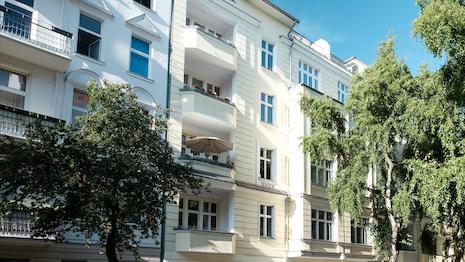Luxury real estate prices around the world are growing at their slowest rate in almost a decade, despite the rise of global wealth.
Knight Frank’s Prime Global Cities Index for the first quarter of 2019 showed that prime price growth has dropped to 1.3 percent, down from 4.3 percent two years ago. Since the first quarter of 2009, luxury real estate prices have climbed an average of 57.4 percent.
Knight Frank tracks the top 5 percent of each city’s housing market.
Europe dominates
Out of the 10 cities with the highest rates of growth year-over-year, seven were in Europe.
Berlin led the way, with prime real estate prices growing 14.1 percent in the last month and 4.5 percent in the first quarter. Frankfurt landed third on the index, with year-over-year growth of 9.6 percent.
Moscow joined Berlin as the only city with double-digit growth, with prices increasing by 12 percent.
The remaining European cities in the top 10 were Edinburgh, Paris, Zurich and Madrid, with Geneva landing in the tenth spot.
Tokyo and Delhi were the only Asian cities in the top 10. Although real estate prices in Tokyo rose 8.4 percent year-over-year, the market declined by 2.7 percent in the first quarter of 2019.
Four U.S. cities were included on the index, but prices in New York fell by 5 percent in the last year and 1.8 percent in the last three months.
Luxury real estate prices remained stagnant in Miami during the first quarter, but climbed 3.0 percent year-over-year. Los Angeles and San Francisco each saw prices grow by less than 1.5 percent in the last year.
Meanwhile, two Canadian cities moved in opposite directions.
Toronto’s prime real estate saw growth of 3.2 percent, higher than the index average. In the West, prices in Vancouver fell by 14.5 percent — the steepest drop of all 45 cities evaluated.
Rising interest rates and tighter government regulations have contributed to diverging real estate trends in Canada’s luxury market. Some of the difference can be attributed to provincial governments that have introduced their own regulations to steady the real estate market and avoid a bubble (see story).
Global trends
Political and economic impacts had an effect on real estate throughout the last year. Knight Frank cites the IMF, which projects that 70 percent of the world’s economies would see a slowdown in growth in 2019.
This is apparent in London, as Brexit remains postponed. The city’s prime real estate prices fell by 5.1 percent year-over-year.
Despite uncertainty surrounding Brexit, there are indications that the prime London residential market is headed in a positive direction. An earlier report from Knight Frank shows the number of new prospective buyers in the market rose by 5 percent to end 2018 (see story).
Financing has also become trickier in recent years, even for affluents. The U.S. has raised interest rates nine times since 2015, impacting currencies in other countries as well.
Raising rates are usually seen as sign of confidence in a strong economy, though many – including United States President Donald Trump – have argued that interest rates are increasing too quickly. There are also indications the Fed is planning at least two more rate hikes in 2019, further impacting affluents looking to purchase property (see story).
{"ct":"XrBIxIjHZI5Q2eabilg4RCYrSL+\/ccaLBjWlG6Ap9ORyWSJ\/9ddBpCuvz95\/Yfn9qSNgpno4zbau8d6obvxqlF8Ff+yTIwLY16tWX6mrj2PS7k2Y3Qg4N0vprtUqajhzbN7X3KntIW+JXs7EwazhxJh+Z4\/wUSZqEMdz7xQGq3fV2KlG5VBHdHxdD2I\/kz7VEdG7nz2ypDFflG8T6HVtNoOEIGzHBkL7GzIgG0\/NF4xAozLYNv+MDjmDU\/8yhqcLOPbHB5nNglIIGY9gvU0gr4527GbUX+BXk2BKn533rVfJ62IYnJs3viA36xfeIf8ZI\/X1fWUdJYrncQhKj9tSf63\/qr9jqb7kUW8J43CZP+n0PHuvC+3\/PW+39kChzqGIgDjEAR\/0LwKa16yr6vVejK9D9OiOkP1yDakfsQEqi\/zKjX23vBgXMW\/yLNoir1Ed4\/HjQC87xvW3FXMNoT\/0gFTz98ZfjdWvWj8JojZnclKxvjpua7npkO5E1RdHD1QxKFQsuX7E93rqCyWC986kA4rbJvHywTBf0qKbMN58+nmMXOGF42n7w\/VFx4IIbPJksStqtHEhgGgPocU2CpQQslev2qZ45jhWi9hti8KT\/sMQdsAxwSJkYhqSaa97pX+EICsD\/P8Gqrbpl1yamepwujQ+gNHslWs5lYohY\/2slzS\/pMFW7XR2dpOdojLZfoPMcXkCI1j12zkZqxx3SP8etqZYmoKYT3BU0ejfvgLZwtFS4Yxj0XJpRGcZgbwdwssVrwo9C3hWehVClvvi9sv8NavOj0Xq5bMISBqNAgfmzQmwNaHaLPG4bF2ZIItaphxXuzWQ+Rh58RXy4D5EcnGYuDrKlLL5VZd8nJnMGbfNgVNjj4IttbEBHwALbmRWapK6u6+2tE\/us1taD+LX8WMDiZeJY60sLq6ubHHXLqCw680hJajuIRTAhvWqoEcJy6j1o490iG3\/uYaSKxv6VVWtPobTibUy8Q7GubX+d8o2F4ROPFTJQLqFkJnMdcAPTTbryqbAx1n6DUiGbWaaqDwrPONG8bwkT1VfSi31ISCRAog1kxfSkqj8nOT\/zQksJmezzEs3xlSesYOjqSRC87oocSifKmPX0JtRNtSwqlmbP9DIrXgaV7CBX5OssLn7O1ZLFu0bBmd3IGo1w0b5FBaCbWySNLBxRKGORsEiavcEiLpftgsNIXfKEgRjaPKz+Qr0xtHlyIHBiUrYb4+3B22Spu5i9LGDgxxhKSKVLzjOZgDm0Q+LXJYpxKpCRBL5cA\/OJ\/4Qh0kCt4uNrSItNTDKZrdRzVYainfvl\/jr49giaobCks1uNy3Rd7N48NUF9t3VBh48KEodlcu6+buh8iybusAi2avFXxe+kBtsOKXcpi5hILgR8oll6hhQPcDpUpaVe6G+xhRjH\/TvbmVgC4Xk5wYiexGtjlO1tTfbz3hNlxUSU3KlzS467OsrR69vWRY8oYxrT1th+Ozyfhab6sNqsL2U6OH5m0gcZwUNGC1YlhAGZX075pB12qJioAdZnEx\/3qYz0T\/b7\/qPz6+YMnRcDKfyC4wRwnLPLUsIh9ANmMAstOly1xsyPdXzbqhhLZQj6SlJ+IXpVhy4U490enlnYXt8sdYc3BEk+29dQira4g3tbGp+CImM0XSSZO1vyU7a\/i+62JGCaodTMS0Hul0YIPO8IsBKUqih06K1t+RGbf5tb\/wmYoBL6ra4IzKQmhxiXbEgL7GJ18rWhLqPefBiGkF++W+KGWBRh0UpNOe5W8wz24q6H6ZIgrB7Ic1J79xdKqkkB9VOcPKPKz6NTjoaB1TtYD5FbM10KF27mnnkoJ00nFqCNm28mpxUy3PMK+acGsugrukp1hGfoB\/iPV0Gg0FYHUaxTFj0zfqddzdG41JD8D\/p9BpXR\/kqoycaEwSzGmXq2Z89QwyY9petIYwmQLhXCn3PmQE+Sz1JuLRFYmhlxj0RXYg7D3Oj5uRfeWFSliu3TC+Wn5Jc\/UhhBnv0sLsEpVOOMY9GXpN8sSHa5M9o1e8kz12CFbOLxTM05AqMKon8g14LWODt\/VJCESSuFZQNVqHy58HzADIVlduFrfNke04WZl+Eupf6j0fzm1kRvKTODv+InZHAVpLYTnA\/zqhLX\/aMI2hj0QLFolEAE8FtkuTdNvHAqLi24ilVotUdFbmbPhChUE49TMMC08+x\/Sq2Lcoaw85mlVAWUpcumvre9Leg9FJmG1FGrGHV8\/TpTcOyxI3YHWgAFptel2S6O8cz1hOJU4+aRm43C5fa5R7y8tZs62\/3aAqk01WgKs8PPVkEzmvcPxgRoseXBOQ9wrAWeaxvSx3NFwDh43jkynKIfQLOJXbgqt5rw9uiWeBL\/HJv2Ff6FG30dREAGp2i00LmX8J0ElM5IGSfrIKIbordNUcfhYYk97jwCZlYop6tv77SjwnJXAqgCiMkFC8sEktm92ryxPNZmEdLPKKdHSIf4VJPIR8yI4+7MoUmcdPo2lpWE1M\/iMRIx1ShBlCnMwbvAYkdi61tPAxq4od3DTRRUpstHH6HC7m8eaOaKepi7GIaMrczu4FJkQ+Lq47MkO+MwXecp7HCf79w6J0ohHoT4X70DRjCC98OP6Jux3sZZ0rbjCpwqdX1cm\/Ok8vfArfE2KZQV5pRLwqTnQb1dt\/YC+RqIRag4wl8BLJkGTLYtPWdKbBiz6d377a4WPZrMn2NKWRLcxDhTvQYalGGo4iiRqvMjfFGLSRdUTlXm4vkApbNZdidpnpvvzIqXWsHsO8QZaEVZgrOPsCIdcAU9s\/zMvvtuXw7RpK2FGUP3VKwsrKHJgcMj9QmTQTog9TKLT73f\/yByLKytnAk2LsyDu4ZsxYmrmyLlzHSKCV4FX9Iv0iqN6LhDbGm3RTw6C6ZIwqsBqbBfyjBiEz8WXbZ2NcfUHP8oWD8LsV73Ex2oG6lGfefeU3NVSQ8HOP7yAS5GP9EN2kIVQu2YgjESrzXRB79F2KtSvBgeijrCgR0Gku1L9dX8IBeC0DD6fIgkEBaOm\/uzIqOE\/xK6oQBbLncIqPPdvfe0WPn+VizMJubgrKeqhfNv1cqtLJBrjplPAxnxgZcf5opggTmGSrVVU2mTSKBll3HPJCPncjilcBsrd2fQwAgBkh3Wgf\/\/ERyTUGxYPh+Un2Bxa4Fhrm2S\/sochgmTa1fq6R+DCU7Zs80bx4B+\/plxLQiLd+ZqhXfBjL9wzZtSv+5AEhvtoDus6zS1ds0gFRgxkn6LbhLyqu7xCwbohnFEDIcE0gEOJID1h5PvuIAjdaJVnXWFaUAx+ekNh1MrNvJQISd6O8FRDuvecg2jdOrwkPKLW\/YWjRYnDe1O7nK5BfdWIwmjfC85Zp4FGzYUVgK0iUlT7lagBSuJQHVqjhLgKulfyJluAnLgOiW8BLKHsO3Hf2uW4k1tr4TZ8Bqmn178LJDb1pYl4jHcux8aLnvoT4K0JcGuHzrEYOJ1jbUbfOZRlsMQevJJnHlBEcMMxlZgDyLRsQtxDhGpSMTxdpHd7bOjdpYjU+j7VpE6TtZMONS7vr30l4XkcFje0B+SKx2BeMG2tltxQuZkTJZ\/7bDtXp0hwu\/3d5BdUOGhMjcYlZQUdEX1QhLwwhOev7PvHV2Y5bqZUp3D0Yn41qRYfoZVtAoF1yFPFa569XWIu5BY0Xz1Xr\/Qk+FNbQvAdH5OBUahEHoh0+hlXgnU0RmbVKCJfLTc0bJ+P0C6yM4xPxVF9sFIJMcgEUbf2gqlSfWrMhYnS77TpepeXU\/ICRUvf0sF0mkY9vR\/USiqFUC8DgelpC8gWiMfauunelaub8v3AEGPS6oUGS20tQXzmz4Y7IAhskQROIIBwib\/KLZoN5r6\/czxqJ8adQLjt4C9ht4yeGKSCsY1s93zrpqbPFxupoKJFG+DKO\/gIjJ3BRKS3s4pL6Ww2rSLznZE1jxe0Od0LsdrnQ6veZzipIWcM9pOxZEbj09oTBSra+3kzVMGJ3\/Sb9mr6416LyH+Culp5Gtt3K27NQt8w90SJM2BHgiL4TYQLUmGEGr1L2pssI2yOWaHXNsejezNfVuKcEldBBCen7sqx3YhwePKZV+fMx4rkVjqYOcsl16J7cuqaUVSSxJIYTidi6akm0ep3Sb2TCMNntnjU5Ov5+57hOoP7I4IJawDpa0xnRuwjo8XsDns9MpFhYOX4ihwvbOyilglicDHvV5hJoElNspxYtnx+NioRSPJ\/MAYAAfaX0DCd2TcsP0cHlCiqkTSVwWHPO7Wsss+hKldxZ42h1QzkANj7HqOYsrtfszrzc37\/2Az\/gDCr9DK0VRzXhH+c5iZK+y+OJKG9eCnIYbaRnsVCQMBZP36CZQbNxnIwEaJUO14HRfDVR+W14qk1pceAeolrAFpppXP9Q4A+M+7onlz02VWyMWb79n+Xj1\/6p3tyY6wO1GjpTVu4dfdnFEau72UFsT3vkS+egDLH41hxCDvzC5RBmeyglXTihdQa8kqchliWChqrGvh4B1U9J7BFISVygWb4G2A0OfwIihAbqvNZmiSJa3cdCoTEcb+SHcuafqto3APKo6AKzGOZreTJ6HLXDbHqu\/c3S+jBcnHCmpQs8REGLuAd0dtFAscxX1+uLv+y8+Opmolqe5bD84HwH1k230BOAlyzW2nC06QbvU8NEb3+MY7QpGVNusLFeuJKtAFCLbJo+mfz8vH9RvVQY0lx0\/WvyxgG7+GZQYMzTNkjWM+0Xcrb8RDCX8VTN0e\/AVJkJJMFnx0UBHuOFSYKE2\/b7skIVnNFlKffQn7ZB1rNLQEUXGTyrf+KIKLOgI4EJG4HlZSHkvJIVz41rRJq7tARw0NUgC3aEQrRTXWl\/thHZWsvpsu7ez7uIovwY9wNStQvDLcQnjzhPOmvQC5B\/DMAkUY4DpDdE43EzY5aSQbi9xey4gJPm\/SOTHuOvptAj2y5ufiBP+P0NTv4rVy3BQVc7YBoOb3Mg5xZn\/1Tm3rDoymAyBQEBTwtDMgVLTMoKks2BZJwhFuyzni3mvBDD9Yd6FBdlaYBYEIWGhvRYHRCNuqVanZbzr3XFdP2qYfIflavudG6kUbUUY6oDTuHT8ZdSzjMAP4MIdbjaTThQc+M+imFDAxf4VutghaSVrgwnWxHvqLKMD2ZeuTPQnhqFJTN2jDkyTrBJ3alj+kef3M\/VNJoa2JkX1p2Xk3qo5DA5GpfLMujIIMT7CIXGYwmUGvVJ6RZ06QAMlwbLsD+WiBPtyZ94d1nJVOabAtNHLbXJ\/jnasuMBdzOL1C\/cpfJGC5lnqFygVzUt3S5nwkwxcxO8K+DthoRJnYe9DyMNihGuTz5hANpcr8E0Rea2JgmsJjiQJfV7NpFaJittHjz1ULU7aTOVkDouQBcgY4yyOBkm232OJghX90YI1ex90LaurI08NMf2HFhu7o\/9aTSeIO+a3q85cvyPKrVS1Rm097\/JVLvSr5cymipH4zOjWGbhxjTmxMYhZrBxYYEUJhZ5cUj0gYSoVUMqZgwTPhlE4WwqXayZZsnFczhMk9BKuWm4QiaWruImEg9iI89Cdaq8djlCefXjaq475r97ZEaoyeb0fZ96nuZJMclLAkroV+RAY5bdmyWM=","iv":"5f0d97f494fab3614a9e17ffe8c6e6b2","s":"c1aee696c2800a43"}

 Luxury real estate prices in Berlin grew more than 14 percent. Image credit: Knight Frank
Luxury real estate prices in Berlin grew more than 14 percent. Image credit: Knight Frank